The Checker Maven
Jump to navigation02-22-2020
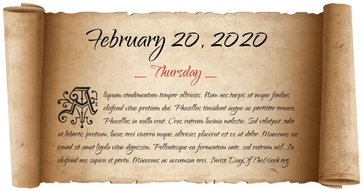
This column will appear on a very interesting date, in a very interesting week. How often do we see dates like 02-20-2020 and 02-22-2020? There will be another such repetition in 2022, but then we'll have to wait until 03-03-3003 for something similar. Perhaps The Checker Maven may have even ceased publication by then, although one never knows.
This week's dates give a bit of a hint toward today's problem and today's theme. See if you can figure it out. Here's the position.
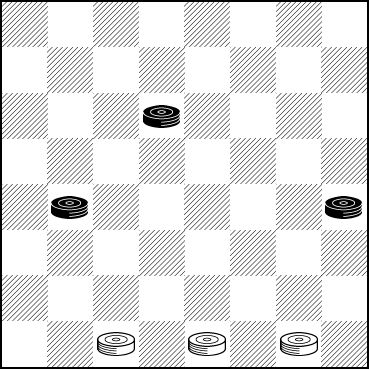
WHITE
White to Play and Win
W:B10,17,20:W30,31,32
This is definitely not an easy problem. Although it will be made easier if you can correctly identify the theme, it may still be at or near master level. But no matter what your skill level, we urge you to try it. And no matter how much or how little progress you make, please take the time to click on Read More to see the solution and one of the most interesting sets of notes and commentary we've published in recent times.![]()
Solution
Did you get it? The theme is 2nd position, as hinted at by the dates 02-20-2020 and 02-22-2020. But there's much more to it. Please continue on to the solution and notes, assembled by Brian Hinkle, who was assisted by Bill Salot and Jim Loy, a powerhouse of a checker problem team if there ever was one.
| 1. | ... | 32-28 |
A brilliant side move. The tempting 31-27? allows Black to swap and draw by 10-15* 32-28 15-18* 28-24 18-23* 27-18 20-27.
| 2. | 17-22 | ... |
If 10-15 31-26* 15-19 26-22 17-26 30-16 White Wins.
| 2. | ... | 31-27 |
| 3. | 10-14 | 28-24 |
| 4. | 14-17 | 24-19 |
| 5. | 17-21 | 19-15 |
| 6. | 22-25 | 15-10 |
| 7. | 25-29 | 10-6 |
| 8. | 29-25 | 6-2 |
| 9. | 25-22 | 2-7 |
| 10. | 22-17 | ... |
If 22-18 7-10 18-22 10-14 22-17 14-18; same.
| 10. | ... | 7-10 |
| 11. | 17-13 | 10-14 |
| 12. | 13-17 | 14-18 |
| 13. | 17-13 | 18-22 |
| 14. | 13-9 | 30-26 |
| 15. | 9-14 | 26-23 |
| 16. | 14-10 | 23-18 |
| 17. | 10-6 | 18-14 |
| 18. | 6-1 | 14-10 |
| 19. | 1-5 | 10-7 |
| 20. | 5-9 | 7-2 |
| 21. | 9-5 | 2-7 |
| 22. | 5-9 | 7-10 |
| 23. | 9-5 | 10-15 |
| 24. | 5-9 | 15-19 |
| 25. | 9-14 | 27-23 |
| 26. | 14-10 | 23-18 |
| 27. | 10-6 | 18-14 |
| 28. | 6-1 | 14-10 |
| 29. | 1-5 | 10-7 |
| 30. | 5-9 | 7-2 |
| 31. | 9-5 | 2-7 |
The tricky part of this win is to park a king on square 27 (instead of 19) before the swaps are forced.
| 32. | 5-9 | 7-10 |
| 33. | 9-5 | 10-15 |
| 34. | 5-9 | 15-18 |
| 35. | 9-6 | 18-23 |
| 36. | 6-10 | 23-27 |
| 37. | 10-6 | 19-15 |
| 38. | 6-9 | 15-10 |
| 39. | 9-5 | 10-6 |
| 40. | 5-1 | 6-9 |
| 41. | 1-5 | 22-17 |
| 42. | 5x14 | 17x10 |
| 43. | 21-25 | 10-15 |
| 44. | 25-30 | 15-19 |
| 45. | 30-26 | 27-32 |
| 46. | 26-22 | 19-24 |
| 47. | 20x27 | 32x23 |
| 48. | 22-17 | 23-18 |
| 49. | 17-13 | 18-14 |
White Wins. The solution is rather long and can be viewed in this animation.
This setting arises from run-ups in the Single Corner and the Cross (both with colors reversed).
| 1. | 11-15 | 22-18 |
Forms the Single Corner.
| 2. | 15-22 | 25-18 |
| 3. | 10-15 | 18-11 |
| 4. | 8-15 | 21-17 |
| 5. | 9-13 | 24-19 |
| 6. | 15-24 | 28-19 |
| 7. | 13-22 | 26-17 |
This midgame arises from the Cross by 11-15 23-18 12-16 18-11 8-15 24-20 9-14 20-11 7-16 22-18 15-22 25-9 5-14. Same, colors reversed.
| 8. | 5-9 | 29-25 |
| 9. | 4-8 | 17-14 |
| 10. | 9-18 | 23-14 |
| 11. | 8-11 | 25-22 |
| 12. | 6-10 | 31-26 |
| 13. | 10-17 | 22-13 |
| 14. | 7-10 | 27-23 |
| 15. | 11-15 | 32-28 |
| 16. | 15-24 | 28-19 |
| 17. | 10-14 | 19-16 |
| 18. | 12-19 | 23-16 |
| 19. | 14-17 | 26-22? |
| 20. | 17-26 | 30-23 |
Same, colors reversed.
264 years ago, in 1756, William Payne published his setting of Second Position. Then in 1808 Joshua Sturges published a setting that arises earlier in play. Later, in 1852, Andrew Anderson published a setting with a still earlier appearance in play. (All three can be found in Ben Bolandís Famous Positions, p. 52.)
In 1953, at the age of 15, Ed Atkinson went one better with a setting that arises sooner than all three of the above. He eventually published a study based on it in the February 2017 American Checker Federation Bulletin.
Inspired by Edís†setting, I (Brian Hinkle) composed the earliest possible setting. It is physically impossible to set it back any further in play.
Here is my setting.
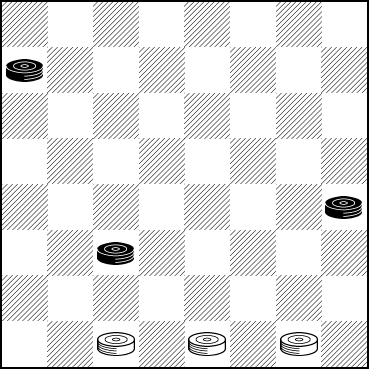
WHITE
White to Play and Win
W:B5,20,22:W30,31,32
Bill Salot, after seeing this last setting, composed five additional settings that arise just as early in play. He noticed that the piece on 5 could instead be placed on 6 or 7.
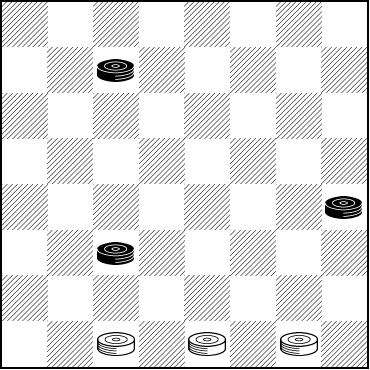
WHITE
White to Play and Win
W:B6,20,22:W30,31,32
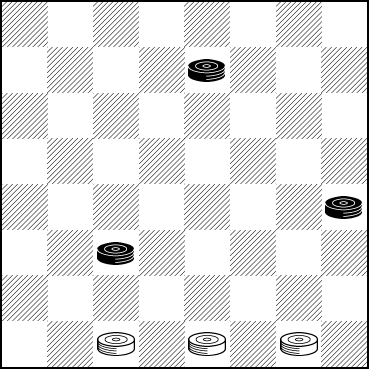
WHITE
White to Play and Win
W:B7,20,22:W30,31,32
Bill also composed a further two settings.
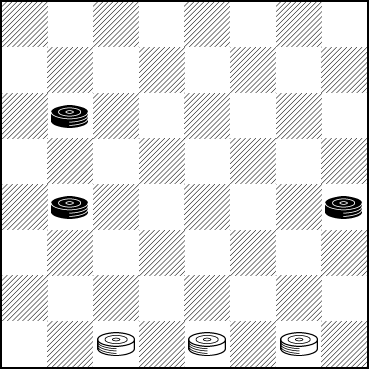
WHITE
White to Play and Win
W:W30,31,32:B9,17,20
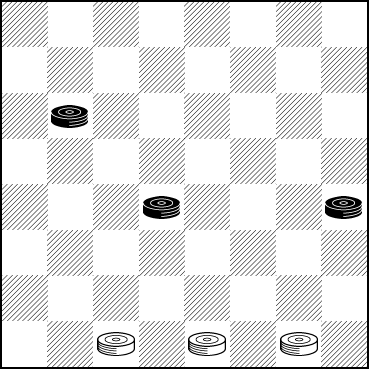
WHITE
White to Play and Win
W:W30,31,32:B9,18,20
Billís fifth setting is the featured problem of this Checker Maven column, selected both because it makes an excellent problem and to show the game run-ups.
The run-ups were created by taking the most natural looking of these six positions and then setting them back into about 25 different mid-games. Next, these mid-games were forwarded to Jim Loy, who used his Aurora database to check for transpositions. Only one of these matched: the one from the Cross. Later, I discovered the transposition from the Single Corner.
Note that this same process can be used to try to discover transpositions for any position and show how it may arise from the game starting position.
Can you discover any more related transpositions?
If you do, or you would like to discuss problem composing or just checkers in general, then please contact me, Brian Hinkle, at sbhinkle@charter.net.
The Checker Maven thanks Brian and his team for this excellent exposition on Second Position. We cordially invite Brian to do a writeup on Third Position in the year 3003!
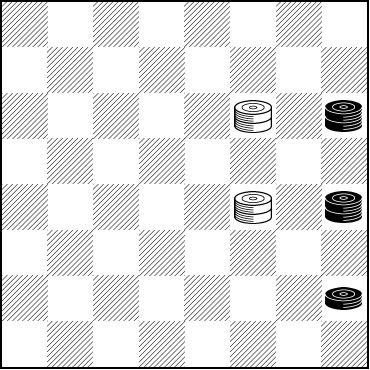
Third Position
A final footnote: we should have mentioned some interesting dates in 2222, such as 02-22-2222. But the most interesting date in history has to have been 11-11-1111. There won't be another like that until 11-11-11111. Will The Checker Maven achieve a more than 9,000 year publishing history and be around for that date? One never knows but we wouldn't bet the bank on it!
You can email the Webmaster with comments on this article.
